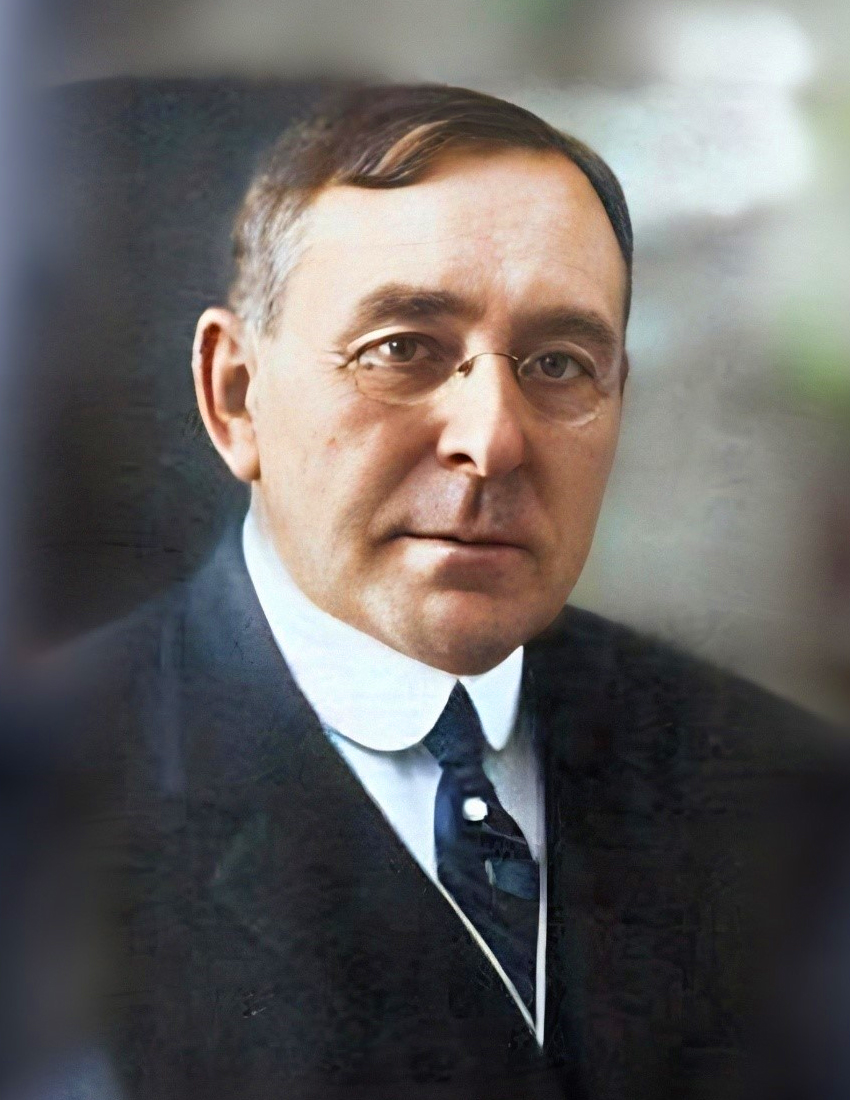Born: June 17, 1859, Richmond, IN.
Died: December 25, 1918, New York City.
Buried: Woodlawn Cemetery, Bronx, NY.
John Wilbur Chapman

Hymns by John Wilbur Chapman
From Ballpark to Pulpit: Chapman’s Mentorship of Billy Sunday
In the bustling world of 19th-century revivalism, an unlikely duo emerged that would reshape the landscape of American evangelism. John Wilbur Chapman, already a seasoned preacher, crossed paths with Billy Sunday, a former professional baseball player whose life had just taken a dramatic turn towards faith.
Recognizing a spark of potential in the ex-athlete, Chapman took a leap of faith in 1893, hiring Sunday as his “advance man.” It was a decision that would yield dividends far beyond Chapman’s wildest dreams.
Under Chapman’s wing, Sunday traded his baseball uniform for a suit and tie, and his bat for a Bible. The evangelist became a spiritual coach, teaching Sunday the art of sermon crafting and the nuances of soul-winning. Chapman’s meetings became a training ground where Sunday learned to field questions of faith with the same agility he once showed on the diamond.
As Sunday’s confidence grew, so did his impact. By 1896, he was ready to step up to the plate on his own, holding his first solo revival in Garner, Iowa. The skills honed under Chapman’s tutelage served him well, as Sunday went on to become one of the most influential evangelists of the early 20th century.
Chapman’s mentorship of Sunday wasn’t just about creating another preacher; it was about passing the torch of revival to the next generation. In doing so, he ensured that the fire of evangelism would continue to burn bright long after his own voice had faded.
John Wilbur Chapman: A Life Dedicated to Evangelism
Sunlight streamed through the windows of a Sunday School classroom in Richmond, Indiana, illuminating the earnest faces of young boys. The year was 1876, and a pivotal moment was unfolding. As their teacher invited them to stand and profess their faith in Christ, one boy remained seated, his heart racing with indecision. This was John Wilbur Chapman, future evangelist and hymn writer, on the cusp of a decision that would shape not only his life but the spiritual landscape of America.
“Would it not be best for you to rise?” his teacher whispered, her eyes brimming with tears. As Chapman hesitated, she gently lifted his elbow, and he found himself on his feet. In that moment, with a mix of trepidation and resolve, young Chapman took his first step towards a lifetime of faith and service.
Who was this boy who would grow to become one of the most influential evangelists of his time? How did this single moment of courage, spurred by a caring teacher, set the stage for a ministry that would touch millions? John Wilbur Chapman’s story is one of unwavering dedication, innovative evangelism, and a passionate pursuit of spreading the gospel – a journey that began with a simple act of standing up.
From Humble Beginnings to Spiritual Giant
Born in 1859 to Alexander H. and Lorinda Chapman, John’s upbringing in Richmond, Indiana, was deeply rooted in faith. His Sundays reflected an insatiable spiritual appetite – Quaker meetings in the morning, Methodist Sunday School in the afternoon. This early immersion in diverse Christian traditions would later shape his inclusive approach to evangelism, allowing him to connect with believers across denominational lines.
Chapman’s thirst for knowledge led him from Oberlin College to Lake Forest University, where he earned his B.A. in 1879. His theological training at Lane Seminary in Cincinnati honed his understanding of scripture and prepared him for the pulpit. Yet it was a personal encounter with the renowned evangelist D.L. Moody that truly ignited Chapman’s passion for soul-winning.
As Chapman pursued his studies at Lake Forest, preparing for a life in ministry, doubts began to creep into his young mind. The certainty of salvation that he’d felt in that Sunday School classroom years before now seemed to ebb and flow, leaving him in a state of spiritual limbo. It was in this vulnerable state that he found himself attending a D.L. Moody crusade in Chicago in 1878.
The fervor of Moody’s preaching stirred something in Chapman’s heart. When the altar call came, he felt compelled to move. With tentative steps, he made his way to the inquiry room, a place where seekers could find spiritual counsel. There, in a moment that would shape the course of his future ministry, Chapman found himself face to face with the great evangelist himself.
Moody, with his characteristic insight, sensed the young man’s struggle. He turned to John 5:24 in his well-worn Bible and read the words that would become an anchor for Chapman’s faith: “Very truly I tell you, whoever hears my word and believes him who sent me has eternal life and will not be judged but has crossed over from death to life.”
In that moment, as Moody’s reassuring voice washed over him, Chapman felt the doubts that had plagued him begin to dissipate. The assurance he gained that day would not only solidify his own faith but would become a cornerstone of his future ministry, as he sought to offer the same certainty to countless souls in the years to come.
The Making of an Evangelist
Chapman’s ordination in 1881 marked the beginning of a multi-faceted ministry. His early pastorates in Ohio and Indiana were but a prelude to the grand stage God was preparing for him. The young minister’s gift for touching hearts became evident, and soon he was dividing his time between local church leadership and wider evangelistic efforts.
In 1893, Chapman took a leap of faith into full-time evangelism. It was during this period that he made a decision that would have far-reaching consequences – he hired a young man named Billy Sunday as his advance man. Little did Chapman know that he was setting the stage for another great American evangelist.
Innovating for the Kingdom
Chapman’s analytical mind wasn’t content with traditional methods of evangelism. In 1904, he pioneered the “simultaneous” campaign approach in Pittsburgh. The city was divided into districts, with multiple evangelists holding meetings concurrently. This innovative strategy maximized impact and became a model for future crusades.
The partnership with Charles McCallon Alexander in 1907 brought Chapman’s ministry to new heights. Their “Chapman-Alexander Simultaneous Campaign” became a phenomenon, with their 1909 Boston crusade drawing an estimated 720,000 attendees over just three weeks.
Beyond the Pulpit
Chapman’s influence extended far beyond his crusades. He played a pivotal role in establishing Bible conferences that became spiritual oases for thousands. The Winona Lake Conference in Indiana, Montreat in North Carolina, and Stony Brook on Long Island all bore the imprint of his vision.
His pen was as mighty as his voice. Chapman’s hymns, including “One Day” and “Our Great Saviour,” continue to stir hearts in worship services around the world. His words, set to music by gifted composers, became vehicles of praise and instruments of teaching.
A Life Poured Out
The toll of Chapman’s tireless ministry became evident in his later years. Elected as Moderator of the Presbyterian General Assembly in 1918, he found the demands of leadership weighing heavily upon him. Yet even as his health declined, his passion for the gospel remained undiminished.
In his final public address at Carnegie Hall in November 1918, Chapman spoke on “Saved When the Lord Comes.” It was a fitting capstone to a life spent preparing souls for eternity. Just weeks later, Chapman’s health took a sudden turn. On December 23, he underwent emergency surgery for gallstones. Despite the doctors’ efforts, Chapman passed away on Christmas Day, going home to the Lord he had served so faithfully.
The Echo of a Life Well-Lived
Chapman’s legacy is not merely in the numbers – the estimated 60 million people who heard him preach, or the thousands of converts who responded to his altar calls. It’s in the ripple effect of lives transformed, in the innovations that shaped modern evangelism, and in the hymns that continue to draw hearts to God.
His life was a living illustration of one of his most famous sayings:
Anything that dims my vision of Christ, or takes away my taste for Bible study, or cramps my prayer life, or makes Christian work difficult, is wrong for me, and I must, as a Christian, turn away from it.
From that hesitant moment in a Sunday School classroom to worldwide crusades, John Wilbur Chapman’s journey was one of continual surrender to God’s call. His story reminds us that great movements often begin with small acts of courage, and that a life fully yielded to God can impact generations to come.
As we reflect on Chapman’s life, we’re challenged to consider our own response to God’s call. What might God do through us if, like young Chapman, we simply stand up when He calls?


